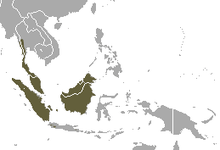Banded linsang
| Banded linsang | |
|---|---|
| | |
| Scientific classification | |
| Kingdom: | Animalia |
| Phylum: | Chordata |
| Class: | Mammalia |
| Order: | Carnivora |
| Family: | Prionodontidae |
| Genus: | Prionodon |
| Species: | P. linsang |
| Binomial name | |
| Prionodon linsang[2] (Hardwicke, 1821) | |
 | |
| Banded linsang range | |
| Wikimedia Commons has media related to Prionodon linsang. |
The banded linsang (Prionodon linsang) is a linsang, a tree-dwelling carnivorous mammal of the Malay peninsula, Sumatra, Borneo, and western Java.
Description
The banded linsang is around 74 cm long including the tail. It is a pale yellow with 5 dark bands. It has broad stripes on its neck and its tail consists of several dark bands with a dark tip. The banded linsang has very sharp retractable claws and razor sharp teeth. It is the rarest of the civets, and is sometimes called the tiger-civet.
Diet
The banded linsang is carnivorous. Its diet consists of squirrels, rats, birds, and lizards.
Reproduction
Very little is known about this linsang's reproduction. It is believed that litters of 2–3 are born semiannually in a nest in burrows or hollow trees.[3]
Habitat
The banded linsang lives in Western Malaysia, Sumatra, Borneo, Western Java, and Thailand. It lives in tropical forests and spends the majority of its time in trees.
References
- ↑ Duckworth, J.W.; Mathai, J.; Chutipong, W.; Brodie, J. & Wilting, A. (2016). "Prionodon linsang". IUCN Red List of Threatened Species. Version 2016.2. International Union for Conservation of Nature.
- ↑ Wozencraft, W.C. (2005). "Order Carnivora". In Wilson, D.E.; Reeder, D.M. Mammal Species of the World: A Taxonomic and Geographic Reference (3rd ed.). Johns Hopkins University Press. pp. 532–628. ISBN 978-0-8018-8221-0. OCLC 62265494.
- ↑ Whitfield, Philip, ed. (1984). Macmillan Illustrated Animal Encyclopedia. Macmillan Publishing Company. p. 92. ISBN 0-02-627680-1.
External links
- Banded linsang media at ARKive

